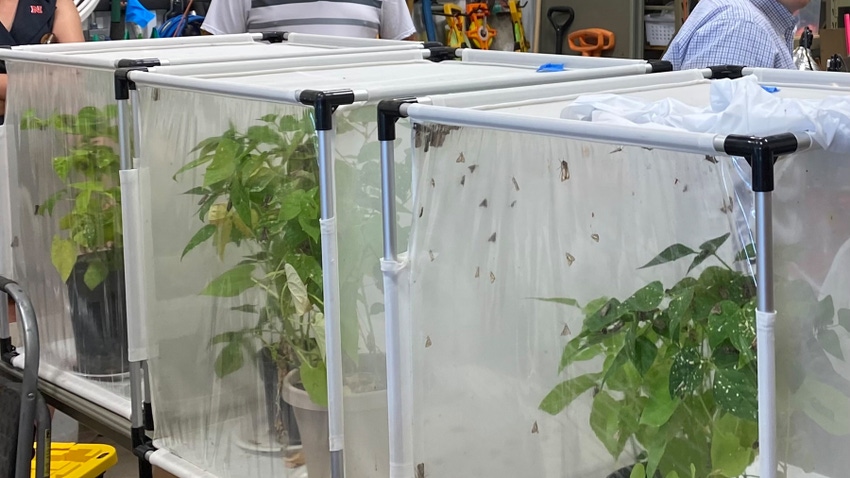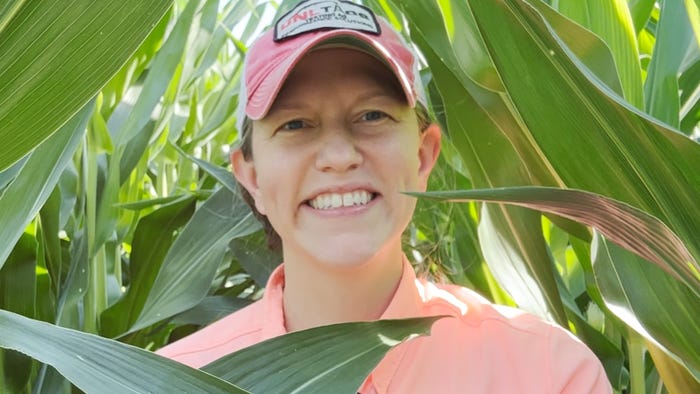August 22, 2023

The struggle continues for farmers in the fight against western bean cutworm, a destructive pest in corn and dry bean crops.
Julie Peterson, entomology professor and Nebraska Extension specialist, is helping combat the aggressive insects with an established colony for research, located at the University of Nebraska West Central Research and Extension Center. Peterson’s team of 15 scientists is raising WBC from egg to moth in a lab in North Platte.
“I lead the Agroecosystems Entomology Laboratory, where we research the biology, ecology and management of important crop pests, including WBC,” Peterson says. “In my 10 years with Nebraska, WBC has become a big issue, and we have a lot to learn about the insect to make practical recommendations to farmers and stakeholders. The biggest challenge is that the WBC is only available one time a year in the wild.”
WBC life cycle
In the field, WBC larvae drop to the ground in the fall and make a prepupal chamber by digging in sandy soil, staying inactive all winter. In spring, WBC pupate in the soil, and moths emerge. By July or August, the female WBC lays her eggs in masses.
In corn, eggs are found on the upper surface of the leaf. The larvae feed first in the fresh tassel and silks, then move to the ear tip and kernels. On dry beans, eggs are laid on the underside of the leaf, deeper in the crop canopy, making them more difficult to find compared to eggs in corn.
Once WBC larvae have eaten enough and reach their final stage of growth, they drop off the plant and burrow into the soil — where they spend the winter as prepupae, starting the cycle over again.
Because the insects are one generation and active for only two to three months each year, there is limited time during the summer months to collect, study and research. To overcome this hurdle and extend research, Peterson and her team developed the WBC colony.

IN THE FIELD: Julie Peterson, Nebraska Extension specialist and UNL entomology professor, has worked over her 10 years at Nebraska to establish a colony of WBC for crops research.
“Adult moths are regularly collected in the field with walk-in trap cages,” Peterson says. “A black light attracts moths at night, and pinto bean plants are placed in the trap to provide WBC adults with shelter and a place for females to lay eggs.”
Establishing a colony in a lab does come with its challenges, Peterson says.
“WBC thrive in the field but are really difficult to bring to the lab and hard to keep alive,” she says. “Because microbes and insect diseases may affect the caterpillars, they get an artificial diet with antibiotics.”
Providing adults and larvae proper nutrition, preparing the pupate and overwintering the prepupae in a controlled environment are all part of the success of the colony.
Only one in the country
“Our lab is the only supplier of WBC in the U.S.,” Peterson says. “We collaborate with stakeholders, including chemical and seed corn companies that need access to our studies to help with WBC control. Funding, in part, by the USDA and Nebraska Corn Board supports our research for use in new product discovery and learning how to control genetically modified traits.”
��“So much has changed in the last 25 years to create a more hospitable environment for the WBC. Surprisingly, the caterpillar is just really wimpy.” Peterson says with a laugh. “There’s a lot of competition in an ear of corn, and WBC are non-cannibalistic.
“Unlike the corn ear worm or the European corn borer, who will eat each other to establish a ‘champion caterpillar,' WBC always loses the fight in caterpillar gladiator wars. By removing strong insect competition with developing treatments, WBC has space and room to expand — not minding if there are multiple per ear.”
Moving east
Historically, the WBC range kept to the Western Great Plains. Today, in part to agronomic and biological changes, the pest is on the move east.
“In the 1940s and ‘50s, WBC was just an issue out here in Nebraska,” Peterson says. “If you were a farmer in Iowa, you may not have even heard about it. WBC is now the major pest of corn in southern Ontario and the Great Lakes region. Information we gather is important to Nebraska, but now important to the rest of the expanding states as well.
“The important thing for us to remember is that WBC are living biological things that change and adapt all the time,” Peterson adds. “We’re all working on the same goal in order to have a better understanding of the insect and how to control the resulting losses in both the quantity and quality of crops produced.”
For more information on WBC, visit UNL’s Agroecosystems Entomology Lab page at entomology.unl.edu.
Wortmann writes from Crofton, Neb.
About the Author(s)
You May Also Like






